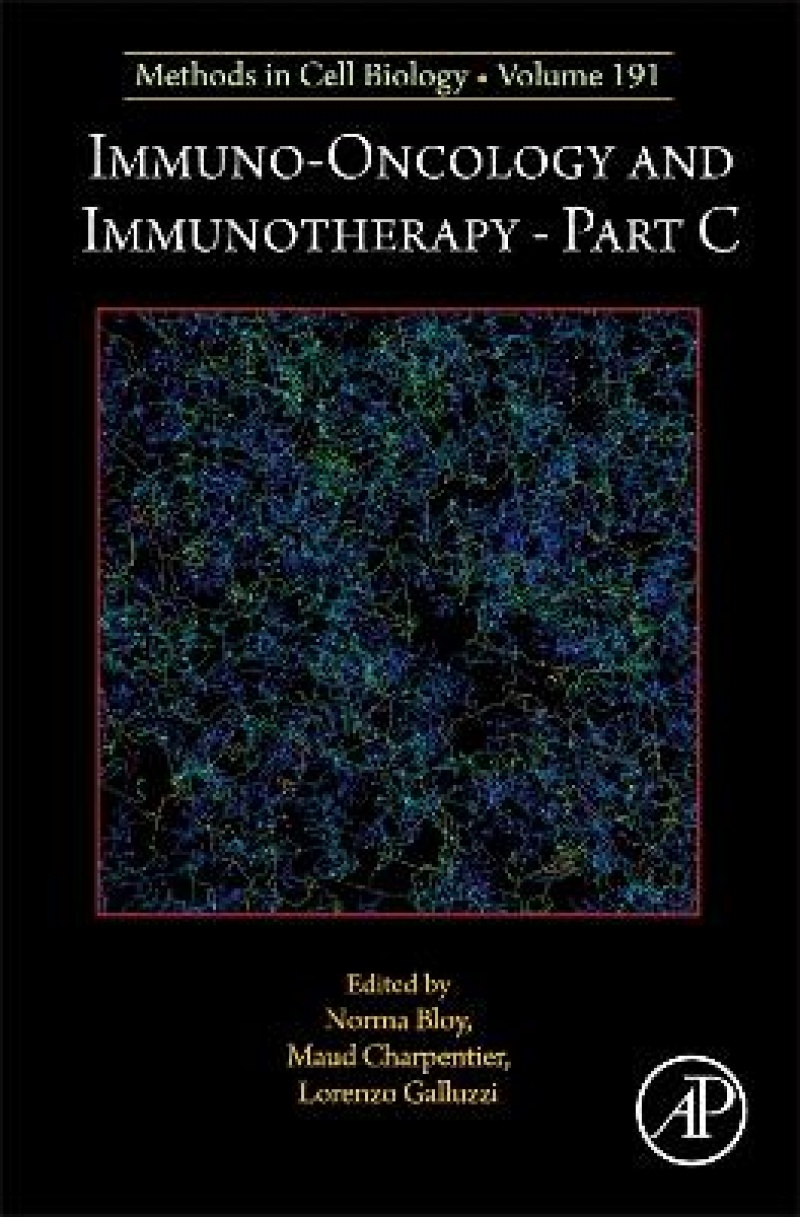Immuno-oncology and immunotherapy, Part C, Volume 191 in the Methods in Cell Biology series, highlights new advances in the field, with this new volume presenting interesting chapters on a variety of timely topics, including Extraction and quantification of histones from human cells, Expression and characterization of Phosphatidylserine-targeting antibodies for biochemical and therapeutic applications, ILC differentiation from HSCs in vitro, Methods to expand human Treg cells and assay their function, Monitoring rapid activation of human gamma/delta T cells by multicolor flow cytometry, Methods to induce T cell exhaustion in vitro, Ex vivo assessment of human neutrophil motility and migration, and much more.
Additional chapters focus on Flow cytometry-based monitoring of myeloid-derived suppressor cells in the peripheral blood of patients with solid tumors, Deciphering human blood and tumor neutrophil heterogeneity: Methods for isolation and assessing suppression of T-cell proliferation, Splenocyte anticancer citotoxicity assessment after prophylactic vaccination or drug treatment of tumor-bearing mice, Therapeutic treatment of tumor-bearing mice with drug-killed cancer cells: a method to confirm immunogenic cell death and assess its therapeutic effectiveness, and much more.
Les mer
1. Simplified acid extraction and quantification of histones in human tumor cells
Lourdes Hontecillas-Prieto, Daniel J. García-Domínguez, Rocío Flores-Campos; Juan Antonio Flores, Antonio Pérez-Pérez, Luis de la Cruz-Merino, Víctor Sánchez-Margalet and Nabil Hajji
2. Expression, purification and characterization of phosphatidylserine-targeting antibodies for biochemical and therapeutic applications
Varsha Gadiyar, David Calianese, Rachael Pulica, Christopher Varsanyi, Ziren Wang, Ahmed Aquib, Alok Choudhary and Raymond B. Birge
3. In vitro ILC differentiation from human HSCs
Silvia Santopolo, Cecilia Ciancaglini, Francesca Romana Mariotti, Lorenzo Moretta and Linda Quatrini
4. Optimizing protocols for human regulatory T cell isolation, expansion and functional characterization
Sánchez-Moreno Inés, Martín-Otal Celia, Lasarte Juan José and Lozano Teresa
5. (1)Specific selection of stimulation-responsive T cells utilizing a short-term activation assay
Christian Peters, Jara Simeonov, Daniel Gombert and Dieter Kabelitz
6. Generation of human and murine exhausted CD8+ T cells in vitro
Rosa Ana Lacalle, Raquel Blanco, Rebeca García-Lucena and Santos Mañes
7. Ex vivo assessment of human neutrophil motility and migration
Noor A.M. Bakker, Claudia Burrello and Karin E. de Visser
8. Flow cytometry-based monitoring of myeloid-derived suppressor cells in the peripheral blood of patients with solid tumors
Anna-Jasmina Donaubauer, Ilka Scheer, Rainer Fietkau, Udo S. Gaipl, Benjamin Frey
9. Deciphering neutrophil heterogeneity in human blood and tumors: Methods for isolating neutrophils and assessing their effect on T-cell proliferation
Nicolas Delhez, Frank Aboubakar Nana, Camille Houbion, Alexandre Bayard, Annika Bruger, Christophe Vanhaver, Sven Brandau, Pierre van der Bruggen and Thibault Hirsch
10. Splenocytes antitumor cytotoxicity assessment after prophylactic vaccination or drug treatment of tumor-bearing mice
Kenny Misael Calvillo-Rodriguez, Ana Luisa Rivera-Lazarin, Reyes Tamez-Guerra, Ana Carolina Martinez-Torres and Cristina Rodriguez-Padilla
11. Therapeutic treatment of tumor-bearing mice with drug-killed cancer cells: A method to confirm immunogenic cell death and assess its therapeutic effectiveness
Kenny Misael Calvillo-Rodriguez, Maria Norma Gonzalez-Flores, Reyes Tamez-Guerra,Cristina Rodriguez-Padilla, Marilena Antunes-Ricardo and Ana Carolina Martinez-Torres
12. Single-cell RNA flow cytometry to assess intratumoral production of cytokines/chemokines
Khiem C. Lam and Romina S. Goldszmid
13. Multidimensional profiling of cancer microenvironments in FFPE tissues by imaging mass cytometry
Marieke E. Ijsselsteijn and Noel FCC de Miranda
14. Evaluation of lymphocyte infiltration into cancer spheroids by immunofluorescent staining and 3D imaging
Mireia Cruz De los Santos and Andreas Lundqvist
15. Quantitative pre-clinical imaging of hypoxia and vascularity using MRI and PET Georgia Kanli, Selma Boudissa, Radovan Jirik, Tom Adamsen, Heidi Espedal, Hans-Olav Rolfsnes, Frits Alan Thorsen, Jesus Pacheco Torres, Bassam Janji and Olivier Keunen
16. Retrovirus-based manufacturing of chimeric antigen receptor-modified T cells for cancer therapy research
Sophia Stock, Luisa Fertig, Vivien D. Menkhoff, Thaddäus Strzalkowski, Manuel Caruso and Sebastian Kobold
Les mer
Edited by one of the best scientists in the field, this series presents the latest updates in the field of cell biology
Authored by established and active cell biologists and immunologist and drawn from international sources.
Includes in-depth coverage and detailed protocols.
Present a highly specialized group of topics that delve deep into new updates and future prospects.
Les mer
Produktdetaljer
ISBN
9780443296208
Publisert
2025-01-16
Utgiver
Vendor
Academic Press Inc
Vekt
720 gr
Høyde
229 mm
Bredde
152 mm
Aldersnivå
P, 06
Språk
Product language
Engelsk
Format
Product format
Innbundet
Antall sider
370
Volume editor
